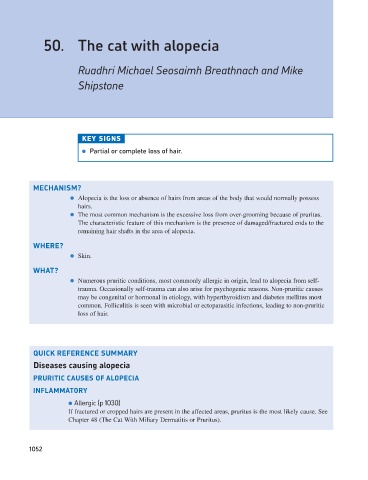Page 1060 - Problem-Based Feline Medicine
P. 1060
50. The cat with alopecia
Ruadhri Michael Seosaimh Breathnach and Mike
Shipstone
KEY SIGNS
● Partial or complete loss of hair.
MECHANISM?
● Alopecia is the loss or absence of hairs from areas of the body that would normally possess
hairs.
● The most common mechanism is the excessive loss from over-grooming because of pruritus.
The characteristic feature of this mechanism is the presence of damaged/fractured ends to the
remaining hair shafts in the area of alopecia.
WHERE?
● Skin.
WHAT?
● Numerous pruritic conditions, most commonly allergic in origin, lead to alopecia from self-
trauma. Occasionally self-trauma can also arise for psychogenic reasons. Non-pruritic causes
may be congenital or hormonal in etiology, with hyperthyroidism and diabetes mellitus most
common. Folliculitis is seen with microbial or ectoparasitic infections, leading to non-pruritic
loss of hair.
QUICK REFERENCE SUMMARY
Diseases causing alopecia
PRURITIC CAUSES OF ALOPECIA
INFLAMMATORY
● Allergic (p 1030)
If fractured or cropped hairs are present in the affected areas, pruritus is the most likely cause. See
Chapter 48 (The Cat With Miliary Dermatitis or Pruritus).
1052

